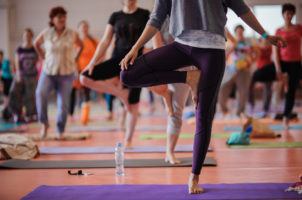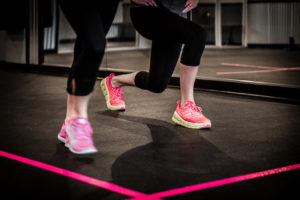Have you noticed that there seems to be a great deal of conversation in training circles about stretching these days? Do it. Don’t do it. Dynamic stretches only. Let your movement be your warm up. Popular media commonly reports that static stretching directly before an event or activity leads to decreased muscle strength and performance. Does it really? Should you remove static stretches from your movement repertoire altogether? Or is there a place for them? It’s confusing! So what do you do?
warm up. Popular media commonly reports that static stretching directly before an event or activity leads to decreased muscle strength and performance. Does it really? Should you remove static stretches from your movement repertoire altogether? Or is there a place for them? It’s confusing! So what do you do?
First, when you look carefully at the data, it becomes clear that scientific studies are far from consistent in their conclusions about the effects of pre-exercise stretching on strength and power. In fact, in a recent article, Mike Reinhold, physiotherapist and rehab specialist, highlighted a Pub Med review illustrating that “69% of studies on stretching show no significant reduction in strength, power or speed.” So… first lesson. Be careful where you get your information. What you read is not always gospel.
There is definitely research that backs up the idea that static stretching can cause trouble before you dive into your sport. But, it really depends what you do with it, and why, and for how long! There are no absolutes. It also depends on whether a stretch is really what you need. Sometimes it’s not about the stretch, it’s about releasing a joint to its full range of motion. And lastly, when Barbie, as a twisted feminine ideal, has been so handily replaced by an image of tights-wearing ”Bend-Wendys”, let’s also remember that limitless flexibility can be a liability in terms of stability. Be prepared to look after whatever range of motion you free up! Otherwise, your potential for injury goes up. Lots to factor in to the equation? Yeah, sure. But if you pay attention to what combination of factors makes YOUR body thrive, you’ll be a lot further ahead than if you follow some media-reported protocol. There are no absolutes. So – before you decide to either stick with your static stretches or do away with them altogether, here are a few things that might help you find an integrated approach that works best for YOU.
1. Static Stretches
There is lots of evidence to indicate that despite its current bad rap, static stretching can go a long way toward preventing muscle strain injuries. So if you feel good stretching before you exercise – go ahead, keep stretching! But be smart about it. First of all, when you stretch BEFORE you work out or compete, keep it light and easy. Make sure that you’re only holding a given stretch for 30 seconds or so. Also, give yourself a little time after stretching before you dive into your sport. You don’t want to go right from a stretch into a hard run. A little static stretching though, can make you feel lighter and looser. If you feel better with a static stretch before hand, do it!
If your goal with a stretch is to actually increase the length of the muscle, save your deep stretches for after you’re finished your activity. This is called a “developmental stretch,” and these deeper, more intense, static stretches will work best when you are still warm, but after the immediate demands for strength, power and speed have passed. You won’t want to do these ones immediately prior to your activity – because you will likely find that your performance suffers as a result.
2. Dynamic Stretches
These stretches use momentum and a form taken from your chosen activity. You are basically warming up by moving through the various ranges of motion that will be required for your sport. Stay loose and easy. You don’t want to start throwing your legs around, past your available static stretch range – because that would turn this into a ballistic stretch, which does bad things to muscles. So lunge, hop, butt kick and swing your legs to your heart’s content, just don’t push past normal range. A dynamic stretching routine is great – just make sure you’re starting in a realistic range of motion and not pushing too hard too soon. Take a little time to get there.  Remember this is a warm-up.
Remember this is a warm-up.
3. Flexibility vs Mobility – Is A Stretch Really What You Need?
This is where things get really interesting. Sometimes, when a muscle feels like it needs a good stretch – it doesn’t! When there are postural challenges or movement inefficiencies, the muscles on either side of a joint work in an imbalanced way. What that means is that the muscles on one side get short, and the muscles on other side get too long to function well. If the long side is the side that is trying to support a load – it gets LONG and WEAK. You can stretch it. And it will feel good. But the feeling of tightness will return again, and again, and again. What that particular joint needs is actually a TIGHTENING up or toning of the long, weak muscle, and and elongation of the shorter one. Often though, what gets stretched in this situation is the long one, because it feels tighter.
If you are consistently tight in one group of muscles, you might want to consider consulting a professional to help you figure out how to balance the joints a little better. It may mean releasing some, it may mean up-training the muscles around others. But a generic runners’ or climbers’ or swimmers’ warm-up may not be serving you well.
4. Pay Attention to What YOUR Body Needs
Regardless of protocols, pay attention to what feels right for your body. When you have a great workout or competition, observe what you did to prepare. What was the order of your warm-up exercises? How long did you spend on them? Remember how you felt just before you stepped onto the field – were you pumped up? Relaxed and ready? Feeling …? What is your best state for performance? Pay attention to your recovery too. What works best for you after the fact, so you experience the least amount of post-activity pain or stiffness? Do you walk for a while, or stretch or …? Or maybe you just climb in the car and go. (Here’s a hint – that last one? Not such a great plan.)
The long and short of it is that you can use science and all the latest studies to give you information about how you might be able to improve your performance and your well-being. But those studies have to be relevant in YOUR body. If it doesn’t feel good, STOP doing it. If it does, KEEP doing it. This isn’t permission to lie on the couch and eat bon-bons all day. Your body needs to be challenged, regularly. But notice when the challenge is wearing you down instead of boosting you up over the long term. You are your own best teacher. Your experiences, for good or for ill, will tell you more than any study ever will. So use intelligent information well. Learn about what your body may benefit from. And then try them out, and evaluate the results for yourself. Because YOU are the one living in your body. Not your doctor, not your trainer, not your spouse or your friends. YOU. Stretch, warm-up, workout, play hard. Take charge. And live large!
If you like what you’re reading here, subscribe and comment! Join the Moving Spirit Facebook group, or send us a tweet on Twitter. You’ll find links in the upper right corner. We’d love to hear your experiences!
